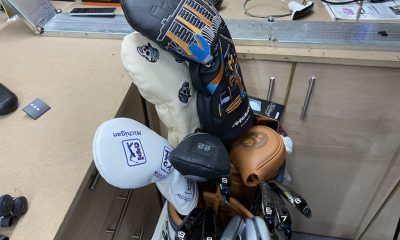Instruction
Keep it simple (student)

The job of a teaching professional is to know the game in all of its complexity and teach it in all of its simplicity. If I cannot put everything I’ve learned on the head of a pin and make it simple enough that my students can understand it, I have not done my job.
My students couldn’t care less about what I know; they only want to know why they are hitting poor shots and what they have to do to hit it better. Much like a building contractor, there are really only two services I offer: build a golf swing or remodel it. For 99 percent of my students, I strongly suggest that they are in the latter category. The other 1 percent is almost exclusively comprised of new players, particularly junior players.
When golfers first start playing, they usually have a preconceived notion of how the golf swing is supposed to be executed. In other words, even before they swung the club, they had a habit. Granted, it’s not likely a very well established habit, but it’s a habit nonetheless. Maybe the habit was something they saw someone do, or maybe other sports they have played suggested a way that they should play golf. It doesn’t matter, because the fact remains that I have seen very few, if any, “Tabula Rasa’s” in the game of golf. If Aristotle was a golf pro, he may never have conceived his theory. The closest we get to the blank slate in golf, and maybe anything, is children.
So I have spent most of my career correcting golf swings. Other than brand new players and juniors, I never, ever re-build a swing. There will always be traces of the old swing no matter what I or any instructor does. And that’s as it should be.
Plenty of players get better by remodeling. Think of it like remodeling your home. You repaint, add a kitchen, or new bathroom — but the basic STRUCTURE of the buiding remains the same. Same with your swing. If you have been playing for even a little while, there is a good chance that, like it or not, the structure of the swing is uniquely yours. So let’s talk about remodeling.
Golfers always hear about “the fundamentals:” The grip, posture, ball position, alignment, aim, etc. And there is no question that these are the buidling blocks of a swing. Or to continue our metaphor, they are the foundation of the house. So we assemble a team of contractors and tell them we are going to build something. If they are starting from scratch, the first thing they would request is the blueprints. The blueprints in golf are these fundamentals. But remember we are not building, we are remodeling.
Where do we begin the remodel? I suggest we begin at impact. I usually begin by observing ball flight and seeing what parts of the swing I can leave IN. Then I have to decide what parts have to go. Every one has balanced an equation in their life. It is the very same for your swing. It has to balance.
Click here to read another one of Dennis’ articles, “Forget method teaching: swing your swing.”
Good players balance the equation, poor players do not. If you have an unbalanced equation you need to balance it, and that’s where I would begin the remodel. It is not like you get to do whatever you want in this remodel, you only get to swing. I will do the balancing. If you have even numbers, you’re doing just fine — it’s when the numbers get odd that I have juggle. A few examples:
- A path to the right is balanced by a closed face; a path to the left is balanced by an open club face.
- A steep angle is balanced by some aim or swing to the left; a shallow angle is balanced by some aim or swing to the right.
- A wide takeaway is balanced by a narrow downswing; a narrow takeaway is balanced by a wide downswing.
It goes on and on.
There are an infinite combination of these factors, but the good news is you don’t have to change everything; “Improve, don’t move.” If you have a very strong grip and you love your hands there, keep them there. But if it’s causing you to hook, you’re not balanced. Keep that grip and change something in your move, OR, try a weaker grip to see if it’s in balance with your existing move.
To be honest, this is the way I leaned to play. Many self taught players have done it this way. If something works, stick with it; if not try something else. Ben Hogan said, “The secret is in the dirt.” Interpretation: Watch your contact and ball flight and make the necessary changes from there.
One final note: If all this is true, why would you ever need a lesson? For many, you don’t; you have learned how to balance your equation. But if new thing after new thing still has you still unbalanced, you may want to see a professional “re-modeler.” We are in the balancing business. We understand what side of your equation has to be changed.
Example: When I say “wide” or “narrow,” I know the necessary elements required to get you there; how to get wider, how to get narrower, less steep, more upright, etc. Solving for X in the golf swing is nothing more that finding solid contact.
Time after time. Keep it simple (student).
As always, feel free to send a swing video to my Facebook page and I will do my best to give you my feedback.
- LIKE1
- LEGIT0
- WOW0
- LOL0
- IDHT0
- FLOP0
- OB0
- SHANK0
Instruction
Clement: Laid-off or perfect fade? Across-the-line or perfect draw?

Some call the image on the left laid off, but if you are hitting a fade, this could be a perfect backswing for it! Same for across the line for a draw! Stop racking your brain with perceived mistakes and simply match backswing to shot shape!
- LIKE1
- LEGIT0
- WOW0
- LOL0
- IDHT0
- FLOP0
- OB0
- SHANK1
Instruction
The Wedge Guy: The easiest-to-learn golf basic

My golf learning began with this simple fact – if you don’t have a fundamentally sound hold on the golf club, it is practically impossible for your body to execute a fundamentally sound golf swing. I’m still a big believer that the golf swing is much easier to execute if you begin with the proper hold on the club.
As you might imagine, I come into contact with hundreds of golfers of all skill levels. And it is very rare to see a good player with a bad hold on the golf club. There are some exceptions, for sure, but they are very few and very far between, and they typically have beat so many balls with their poor grip that they’ve found a way to work around it.
The reality of biophysics is that the body moves only in certain ways – and the particulars of the way you hold the golf club can totally prevent a sound swing motion that allows the club to release properly through the impact zone. The wonderful thing is that anyone can learn how to put a fundamentally sound hold on the golf club, and you can practice it anywhere your hands are not otherwise engaged, like watching TV or just sitting and relaxing.
Whether you prefer an overlap, interlock or full-finger (not baseball!) grip on the club, the same fundamentals apply. Here are the major grip faults I see most often, in the order of the frequency:
Mis-aligned hands
By this I mean that the palms of the two hands are not parallel to each other. Too many golfers have a weak left hand and strong right, or vice versa. The easiest way to learn how to hold the club with your palms aligned properly is to grip a plain wooden ruler or yardstick. It forces the hands to align properly and shows you how that feels. If you grip and re-grip a yardstick several times, then grip a club, you’ll see that the learning curve is almost immediate.
The position of the grip in the upper/left hand
I also observe many golfers who have the butt of the grip too far into the heel pad of the upper hand (the left hand for right-handed players). It’s amazing how much easier it is to release the club through the ball if even 1/4-1/2″ of the butt is beyond the left heel pad. Try this yourself to see what I mean. Swing the club freely with just your left hand and notice the difference in its release from when you hold it at the end of the grip, versus gripping down even a half inch.
To help you really understand how this works, go to the range and hit shots with your five-iron gripped down a full inch to make the club the same length as your seven-iron. You will probably see an amazing shot shape difference, and likely not see as much distance loss as you would expect.
Too much lower (right) hand on the club
It seems like almost all golfers of 8-10 handicap or higher have the club too far into the palm of the lower hand, because that feels “good” if you are trying to control the path of the clubhead to the ball. But the golf swing is not an effort to hit at the ball – it is a swing of the club. The proper hold on the club has the grip underneath the pad at the base of the fingers. This will likely feel “weak” to you — like you cannot control the club like that. EXACTLY. You should not be trying to control the club with your lower/master hand.
Gripping too tightly
Nearly all golfers hold the club too tightly, which tenses up the forearms and prevents a proper release of the club through impact. In order for the club to move back and through properly, you must feel that the club is controlled by the last three fingers of the upper hand, and the middle two fingers of the lower hand. If you engage your thumbs and forefingers in “holding” the club, the result will almost always be a grip that is too tight. Try this for yourself. Hold the club in your upper hand only, and squeeze firmly with just the last three fingers, with the forefinger and thumb off the club entirely. You have good control, but your forearms are not tense. Then begin to squeeze down with your thumb and forefinger and observe the tensing of the entire forearm. This is the way we are made, so the key to preventing tenseness in the arms is to hold the club very lightly with the “pinchers” — the thumbs and forefingers.
So, those are what I believe are the four fundamentals of a good grip. Anyone can learn them in their home or office very quickly. There is no easier way to improve your ball striking consistency and add distance than giving more attention to the way you hold the golf club.
More from the Wedge Guy
- The Wedge Guy: Golf mastery begins with your wedge game
- The Wedge Guy: Why golf is 20 times harder than brain surgery
- The Wedge Guy: Musings on the golf ball rollback
- LIKE88
- LEGIT15
- WOW6
- LOL1
- IDHT0
- FLOP4
- OB1
- SHANK9
Instruction
Clement: Stop ripping off your swing with this drill!

Not the dreaded headcover under the armpit drill! As if your body is defective and can’t function by itself! Have you seen how incredible the human machine is with all the incredible feats of agility all kinds of athletes are accomplishing? You think your body is so defective (the good Lord is laughing his head off at you) that it needs a headcover tucked under the armpit so you can swing like T-Rex?
- LIKE0
- LEGIT3
- WOW2
- LOL0
- IDHT0
- FLOP0
- OB0
- SHANK2
-

 19th Hole3 weeks ago
19th Hole3 weeks agoLET pro gives detailed financial breakdown of first week on tour…and the net result may shock you
-

 19th Hole1 week ago
19th Hole1 week agoReport: LIV star turns down PGA Championship invite due to ‘personal commitments’
-

 19th Hole2 weeks ago
19th Hole2 weeks agoGary Player claims this is what ‘completely ruined’ Tiger Woods’ career
-

 Whats in the Bag3 days ago
Whats in the Bag3 days agoTiger Woods WITB 2024 (May)
-

 19th Hole1 day ago
19th Hole1 day agoBrandel Chamblee says this is the primary reason why Rory McIlroy hasn’t won a major in 10 years
-

 Equipment1 week ago
Equipment1 week agoDetails on Justin Thomas’ driver switch at the Wells Fargo Championship
-

 Whats in the Bag3 weeks ago
Whats in the Bag3 weeks agoTeam McIlowry (Rory McIlroy, Shane Lowry) winning WITBs: 2024 Zurich Classic
-

 Whats in the Bag1 week ago
Whats in the Bag1 week agoKeegan Bradley WITB 2024 (May)





















Marshall
Sep 27, 2013 at 10:16 am
Incredible article. Best one I have ever read on golfwrx.
Thank you for taking the time to write it!
Braxton Felts
Jun 7, 2013 at 11:21 am
Great article.